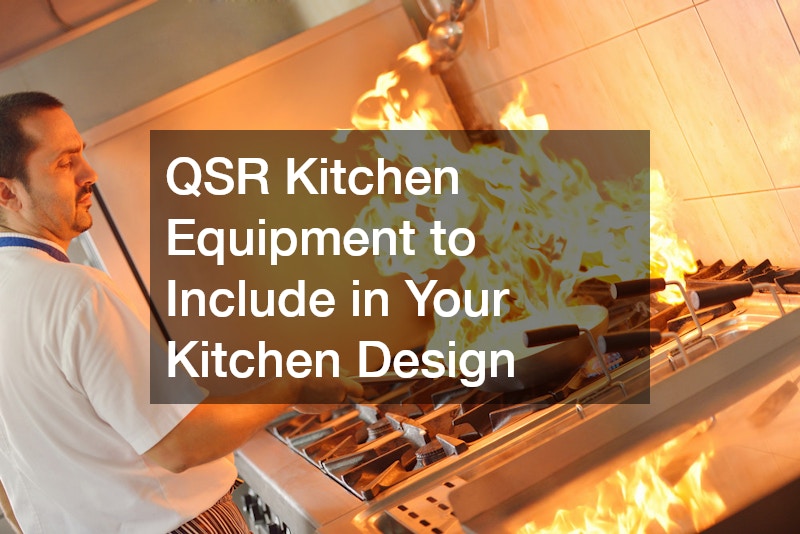In the fast-paced world of quick service restaurants (QSR), selecting the right kitchen equipment is paramount. The efficiency and quality of service in a QSR largely hinge on how well the kitchen is equipped. Streamlined operations, speedy service, and consistent food quality can significantly enhance the customer experience. Having the right QSR kitchen equipment is essential.
What are the essential pieces of equipment every QSR should have?
Refrigeration Units
Refrigeration units are crucial for maintaining the freshness and safety of ingredients. Walk-in coolers provide ample storage space, essential for high-volume operations.
Reach-in refrigerators offer accessibility, ensuring that frequently used ingredients are always within arm’s reach.
Effective refrigeration preserves the quality of perishable items, reducing waste and spoilage. Advanced units with precise temperature controls can cater to specific storage needs. By investing in efficient refrigeration, QSRs can uphold food safety standards and minimize operational costs.
Modern refrigeration solutions are designed to optimize energy consumption. This not only lowers utility bills but also aligns with sustainable practices. Ultimately, reliable refrigeration units contribute to a seamless and productive workflow in any QSR kitchen.
Cooking Equipment
Cooking equipment forms the backbone of any QSR kitchen. Grills, fryers, and ovens are indispensable for preparing a wide range of menu items. Their speed and efficiency enable quick service without compromising on quality.
By choosing versatile cooking appliances, QSRs can expand their menus with varied offerings. Each piece of equipment should be selected based on the specific culinary requirements of the restaurant. The right choices lead to reduced preparation times and enhanced flavor profiles.
Advanced cooking technologies, such as combi ovens, offer multifunctional capabilities, streamlining kitchen operations. Investing in high-quality equipment minimizes breakdowns and maintenance costs. Thus, reliable cooking appliances are a wise investment for long-term operational success.
Food Preparation Tools
Food preparation tools are essential for maintaining consistency and speed in a QSR kitchen. High-performance mixers, processors, and slicers boost productivity. These tools enable chefs to prepare ingredients with precision and uniformity.
By automating repetitive tasks, preparation tools free up valuable time for staff. This allows more focus on crafting meals to perfection. Durable and efficient preparation equipment is fundamental for optimized kitchen operations.
Investing in top-notch preparation tools also enhances worker safety and ergonomics. Ergonomically designed equipment reduces the risk of injury during prolonged use. Ultimately, reliable preparation tools ensure that food quality is consistently high.
How to choose the right equipment for your QSR kitchen design?
Understanding Your Menu
The type of menu offered by a QSR greatly determines its equipment needs. A detailed analysis of menu items can guide equipment selection. Tailoring equipment to meet culinary requirements ensures efficient and consistent meal preparation.
Customizing your kitchen based on menu demands allows for optimal resource allocation. It prevents the purchase of unnecessary equipment and saves valuable kitchen space. By understanding the intricacies of your menu, investment in the right technology can be strategic and cost-effective.
When menu changes occur, the adaptability of existing equipment should be considered. Versatile appliances support menu evolution, allowing for culinary innovation. Therefore, analyzing menu components is crucial to forming a functional kitchen layout.
Space and Layout Considerations
Efficient kitchen design requires strategic planning around available space and layout. It is essential to ensure that the workspace accommodates equipment and staff comfortably. Effective layout promotes a fluid workflow, minimizing time spent on movement and reducing bottlenecks.
Using space effectively also mitigates safety hazards and improves productivity. Considerations such as proximity to service counters and ease of cleaning should be prioritized. Well-thought-out layout leads to coordinated operations, essential for maintaining a fast-paced service environment.
Incorporating flexibility within the kitchen layout allows for future growth and adaptation. Modular equipment aids in reconfiguration when needed. Consequently, mindful space utilization directly correlates with enhanced operational efficiency.
Cost and Budgeting
Balancing cost and quality is crucial when investing in QSR kitchen equipment. By setting a realistic budget, QSRs can prioritize necessary investments while maintaining cash flow. Durable equipment, although more costly in the short term, offers long-term savings by reducing repair and replacement expenses.
Smart investments should focus on reliable brands with a reputation for longevity. Warranty options are also worth considering to minimize future expenditures. Ultimately, cost-effective decisions create a sustainable financial foundation for the business.
While budgeting, energy-efficient equipment can result in long-term savings. Lower utility costs directly impact profitability. Therefore, cutting costs should never come at the expense of sacrificing quality and operational functionality.
In conclusion, the right selection of QSR kitchen equipment is instrumental in achieving operational excellence. Thoughtful decisions in refrigeration, cooking, and preparation tools lead to enhanced service quality and customer satisfaction. By aligning equipment choices with menu, space, and budgetary considerations, QSRs can pave the way for sustained success.
.




